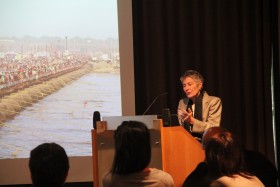For several Harvard professors, studying the world’s largest gathering was the “chance of a lifetime.”
That gathering was the 2013 Kumbh Mela in Allahabad, India, a Hindu religious fair that occurs every twelve years with an estimated attendance of more than 80 million people over 55 days. Because of its size and complexity, the 2013 Kumbh Mela inspired the Harvard South Asia Institute’s flagship multi-year interdisciplinary research project in a number of complementary fields: business, technology and communications, urban studies and design, religious and cultural studies, and public health.
On May 19, SAI hosted an event at the Museum of Fine Arts, Boston, where several professors involved in the project discussed the book Kumbh Mela: Mapping the Ephemeral Megacity, which consolidates research findings and serves as an example of interdisciplinary research conducted at Harvard.
Tarun Khanna, Director of SAI and Jorge Paulo Lemann Professor, Harvard Business School, began the discussion by illuminating the sheer scale of the Kumbh – a gathering 20 times the size of other pilgrimages such as the Hajj. As a self-described “data person,” this experience was particularly fruitful for Khanna’s research, as this was the first Kumbh where virtually everyone had a computer in their pocket – a smartphone – unlocking an avalanche of tantalizing data to help understand human behavior. Tens of millions of messages were sent over the course of the festival, providing rich geo-data to figure out where people are, what they are doing, and where they are going – for any social scientist, a rich reward.
Khanna posed another question: How can the Indian government, known for its bureaucracy, pull off such a massive undertaking with relatively few problems? By studying the Kumbh Mela, Khanna found that the solution lied in the government’s ability to recognize its own limitations. A sense of minimalism was key to the success. The setup is similar to a phone, in which a company, for example Apple, provides the structure of the operating system, then, other people make apps to fulfill users’ needs. At the Kumbh, the government provided a basic infrastructure, and groups, private enterprises, charities, and other organizations, provided the “apps:” food, water, security, and lodging.
This technology was also a powerful public health tool, as it allowed doctors and administrators to use an app as a disease surveillance platform that allowed them to respond to outbreaks in real time. Armed with just an iPad, doctors could bypass the inefficient system of physical patient logs, and respond better to the needs of the hundreds of patients they saw each day.
Jennifer Leaning, François-Xavier Bagnoud Professor of the Practice of Health and Human Rights and Director of the FXB Center for Health and Human Rights, Harvard T. H. Chan School of Public Health, studied the public health issues at the Kumbh. Inevitably, health problems arise when tens millions of people gather in one place at one time. The public health team focused on issues such as crowd mitigation and stampedes, water and sanitation, and epidemic surveillance. “When crowds move, they get in trouble,” Leaning said.
The team found that the event organizers were very well-prepared for these public health concerns. Relative to the size of the gathering, there were no epidemics and few stampede incidences. Leaning attributed this partly to the attendees – they are disciplined and accustomed to moving in large crowds, which reduces the stampede risk. Overall, although some doctors saw up to 800 patients a day, the most common ailments were aches and pains.
The Kumbh Mela has been often studied from the perspective of religion and culture, and as a visual spectacle. But according to Rahul Mehrotra, Professor of Urban Design and Planning, Harvard Graduate School of Design, the festival had never been studied as an urban system – one that is built with an expiration date. This ephemerality is what drew Mehrotra to the project, which he described as an “out of the box” problem to which no one knew what to expect.
Mehrotra and his team documented the incredible urban infrastructure while at the Kumbh, and also looked at the entire planning process, including the initial planning in the year running up to the festival. They also studied the deconstruction, when the entire city disappears in 2 weeks. They were fascinated by the grid system, which provided structure for the temporary city that sits upon a river bank. They found that the entire city is made up of just five materials – and all of these materials get recycled. Mehrotra explained that these types of temporary solutions should have real relevance for permanent cities all over India, especially as India looks towards an increasingly urbanized future.
The Kumbh Mela book, along with the traveling exhibition, has been previously launched in Cambridge, New York, Delhi, and Mumbai.
-Meghan Smith



